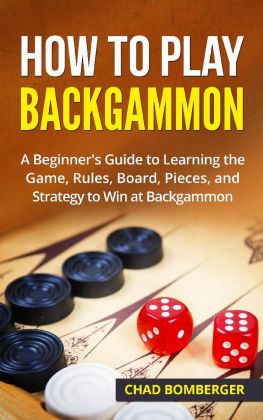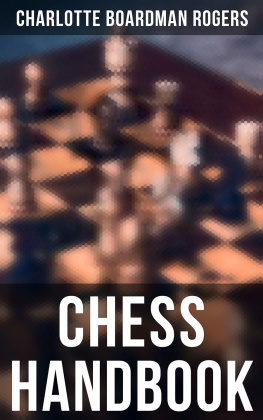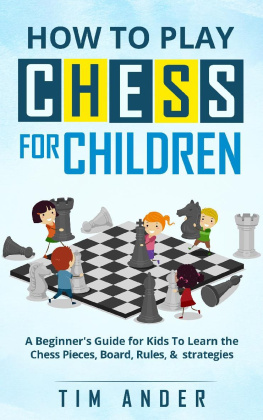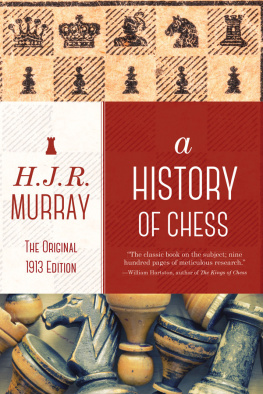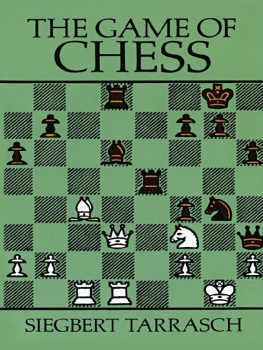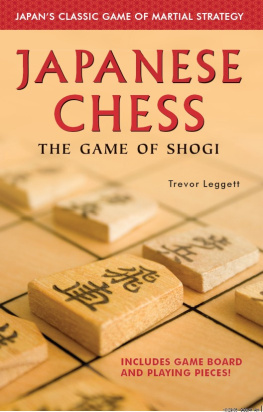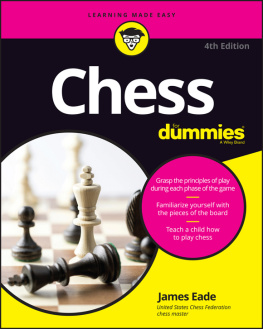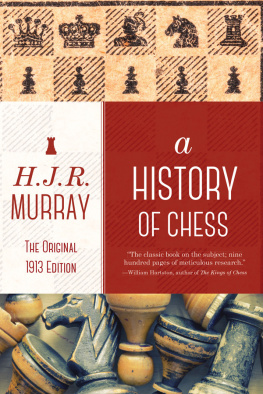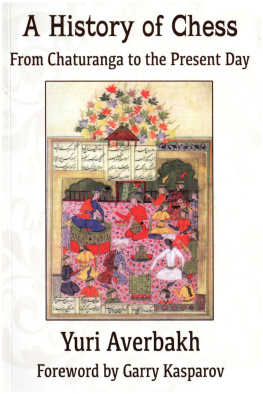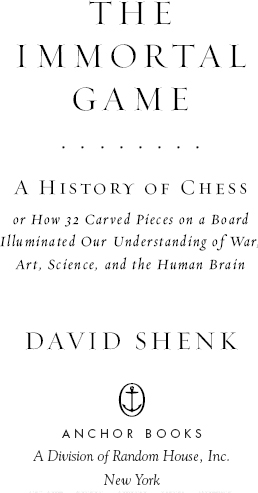
CONTENTS
I. OPENINGS
(Where We Come From)
1.UNDERSTANDING IS THE ESSENTIAL WEAPON
Chess and Our Origins
2. HOUSE OF WISDOM
Chess and the Muslim Renaissance
3. THE MORALS OF MEN AND THE DUTIES OF NOBLES AND COMMONERS
Chess and Medieval Obligation
4. MAKING MEN CIRCUMSPECT
Modern Chess, the Accumulation of Knowledge, and the March to Infinity
II. MIDDLEGAME
(Who We Are)
5. BENJAMIN FRANKLINS OPERA
Chess and the Enlightenment
6. THE EMPEROR AND THE IMMIGRANT
Chess and the Unexpected Gifts of War
7. CHUNKING AND TASKING
Chess and the Working Mind
8. INTO ITS VERTIGINOUS DEPTHS
Chess and the Shattered Mind
9. A VICTORIOUS SYNTHESIS
Chess and Totalitarianism in the Twentieth Century
10. BEAUTIFUL PROBLEMS
Chess and Modernity
III. ENDGAME
(Where We Are Going)
11.WE ARE SHARING OUR WORLD WITH ANOTHER SPECIES, ONE THAT GETS SMARTER AND MORE INDEPENDENT EVERY YEAR
Chess and the New Machine Intelligence
THE IMMORTAL GAME: MOVES 22 AND 23
(CHECKMATE)
12. THE NEXT WAR
Chess and the Future of Human Intelligence
APPENDIX I
The Rules of Chess
APPENDIX II
The Immortal Game (Recap) and Five Other Great Games from History
APPENDIX III
Benjamin FranklinsThe Morals of Chess
FOR KURT
Caliph Ar-Radi was walking in the country, and stopped in a lovely garden, replete with lawns and flowers. His courtiers immediately began to dilate on the wonders of the garden, to extol its beauty, and to place it above all the wonders of the world.
Stop, cried the Caliph. As-Sulis skill at chess charms me more.
al-Masudi, tenth century
PROLOGUE
THINK OF A VIRUS so advanced, it infects not the blood but the thoughts of its human host. Liver and spleen are spared; instead, this bug infiltrates the frontal lobes of the brain, dominating such prime cognitive functions as problem solving, abstract reasoning, fine motor skills, and, most notably, agenda setting. It directs thoughts, actions, and even dreams. This virus comes to dominate not the body, but the mind.
When eleven-year-old Marcel Duchamp first played chess with his older brothers Gaston and Raymond in their home in the French village of Blainville-Crevon in 1898, the game seemed like a harmless distraction, an interesting way of passing the quiet nights in the Normandy countryside. A quick thinker brimming with charm and confidence, Marcel excelled at most things and was well liked wherever he went. Nurtured by his familys deep artistic roots and following in the path set by his older brothers, he emerged in his late teens as an ambitious cartoonist and painter in Paris.
In just a few years, Duchamps intense and unusual work began to catch the public eyemainly for its refusal to settle into a neat classification. He experimented with and quickly passed through the well-established painting styles of Postimpressionism, Fauvism, and Cubism. By his mid-twenties, in fact, he was moving past painting altogether, into an intellectual-aesthetic realm that would come to be known as conceptual art. With his landmark works Nude Descending a Staircase, The Large Glass, Fountain (a ready-made urinal), and LHOOQ (a postcard reproduction of the Mona Lisa doctored with a mustache and goatee), Duchamp gave a jump-start to the sedate art world and helped inspire the Dada, Surrealist, and Abstractionist movements. Further, his art and ideas anticipated the emergence of Pop Art, minimal art, performance art, process art, and, says biographer Calvin Tomkins, virtually every postmodern tendency. By age thirty, Duchamp had produced a body of work that would make him perhaps the most influential artist of the twentieth century.
And then chess took over.
Chess holds its master in its own bonds, Albert Einstein once said, shackling the mind and brain so that the inner freedom of the very strongest must suffer.
For more than a decade, the checker-square board game with four-inch medieval war figurines had been merely a happy diversion in Duchamps life. In his teens and early twenties, he had played vigorously with family and friends. He also worked it into a few early paintings. But in his late twenties something happened between Duchamp and chess that transformed the relationship into an addiction, and eventually an obsession. Slowly, over a few years time, chess moved to the very front of his brain, somehow forcing fundamentals like art, ideas, friendships, and romance to the rear. It was as if these thirty-two inanimate pieces of wood emitted some sort of unseen magnetic or hypnotic power, bending Duchamps formidable mind to its own will.
Strangest of all, perhaps, was the fact that this transition happened in the midst of career glory. Imagine John F. Kennedy chucking politics in June 1960 in favor of billiards. Popular and intriguing, Duchamp was the toast of art patrons in Paris, New York, and beyond. Now, at his peak, he was turning away from all this. Days that would ordinarily have been filled receiving admiring gallery owners and customers, and late nights that would have included dinner parties and more studio work, instead became packed with one chess game after another (after another, after another). Between games, Duchamp engaged in the silent, monastic study of chess problemsthousands of tricky endgame scenarios labored over by most serious players. In New York, Duchamp joined the Marshall Chess Club near Washington Square Park, playing until all hours of the night. During a two-year stint in Buenos Aires, he constantly sought opponents, studied chess books, and commissioned a set of custom rubber stamps in order to play through the mail with his New York patron and friend Walter Arensberg.
By his early thirties, the transition was complete. Apart from the design of some chess sets, Duchamp was producing virtually no art. He shocked friends by bluntly declaring that he was giving up his old career to become a full-time chess player. I play day and night, he declared in 1919 (at age thirty-two), and nothing interests me more than to find the right move.
For hours at a stretch, taking just enough time for meals in between, Duchamp played alone in his apartment, with friends and strangers at cafs, and even in the midst of loud art-world parties. This new life involved not just a reordering of his work and social priorities, he explained to friends, but also his very consciousness. Everything around me takes the shape of the Knight or the Queen, he said, and the exterior world has no other interest for me other than its transformation to winning or losing positions.
In 1923 he moved to Brussels to further his studies of the game, and then returned to Paris. There he would work on chess problems all evening long, take a short break at midnight for scrambled eggs at the Caf Dome, and then return to his room to work on chess again until about four A.M.
Even true love could not moderate his fixation. In 1927 Duchamp married Lydia Sarazin-Lavassor, a young heiress. On their honeymoon he spent the entire week studying chess problems. Infuriated, his bride plotted her revenge. When Duchamp finally drifted off to sleep late one night, Lydia glued all of the pieces to the board.
They were divorced three months later.
Next page



